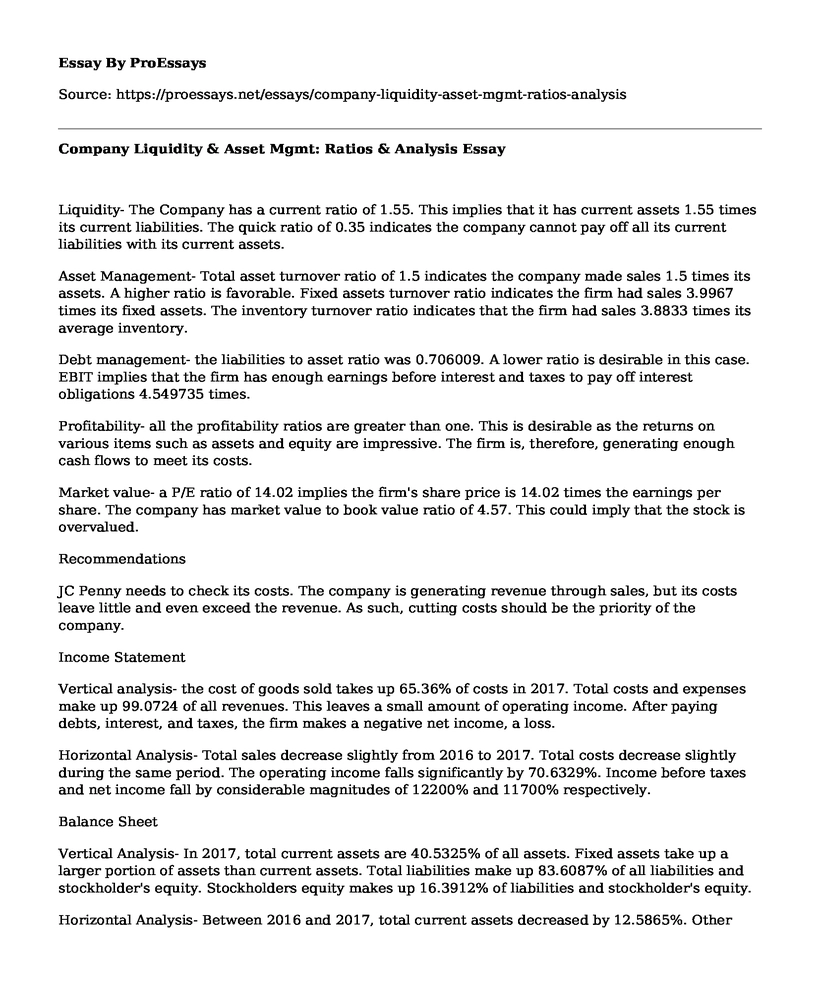Liquidity- The Company has a current ratio of 1.55. This implies that it has current assets 1.55 times its current liabilities. The quick ratio of 0.35 indicates the company cannot pay off all its current liabilities with its current assets.
Asset Management- Total asset turnover ratio of 1.5 indicates the company made sales 1.5 times its assets. A higher ratio is favorable. Fixed assets turnover ratio indicates the firm had sales 3.9967 times its fixed assets. The inventory turnover ratio indicates that the firm had sales 3.8833 times its average inventory.
Debt management- the liabilities to asset ratio was 0.706009. A lower ratio is desirable in this case. EBIT implies that the firm has enough earnings before interest and taxes to pay off interest obligations 4.549735 times.
Profitability- all the profitability ratios are greater than one. This is desirable as the returns on various items such as assets and equity are impressive. The firm is, therefore, generating enough cash flows to meet its costs.
Market value- a P/E ratio of 14.02 implies the firm's share price is 14.02 times the earnings per share. The company has market value to book value ratio of 4.57. This could imply that the stock is overvalued.
Recommendations
JC Penny needs to check its costs. The company is generating revenue through sales, but its costs leave little and even exceed the revenue. As such, cutting costs should be the priority of the company.
Income Statement
Vertical analysis- the cost of goods sold takes up 65.36% of costs in 2017. Total costs and expenses make up 99.0724 of all revenues. This leaves a small amount of operating income. After paying debts, interest, and taxes, the firm makes a negative net income, a loss.
Horizontal Analysis- Total sales decrease slightly from 2016 to 2017. Total costs decrease slightly during the same period. The operating income falls significantly by 70.6329%. Income before taxes and net income fall by considerable magnitudes of 12200% and 11700% respectively.
Balance Sheet
Vertical Analysis- In 2017, total current assets are 40.5325% of all assets. Fixed assets take up a larger portion of assets than current assets. Total liabilities make up 83.6087% of all liabilities and stockholder's equity. Stockholders equity makes up 16.3912% of liabilities and stockholder's equity.
Horizontal Analysis- Between 2016 and 2017, total current assets decreased by 12.5865%. Other assets increased by 6.957929. Overall, total assets decreased during the period by 7.73196%. During the same period, current liabilities decreased by 3.19635% while total liabilities decreased by 9.40237%. Total stockholders' equity increased slightly by 1.846381%. The value of the total liability and stockholders' equity reduced by 7.73196%.
Performance in 2018
The company performed poorly in 2018. It failed to improve and generate incomes during the year. The company recorded decreases in sales as well as a net loss for the year. JC Penny reacted to Sears's bankruptcy by attempting to gain Sears market share. The company has, however, been ineffective at achieving this. The changes made in an attempt to capture Sears's customers are not reflected in its financial statements. JC Penny's stock price has also dwindled as a reflection of its reduced valuation. As such, the company is not out of trouble yet.
Cite this page
Company Liquidity & Asset Mgmt: Ratios & Analysis. (2023, Jan 14). Retrieved from https://proessays.net/essays/company-liquidity-asset-mgmt-ratios-analysis
If you are the original author of this essay and no longer wish to have it published on the ProEssays website, please click below to request its removal:
- Budgeting and Beyond: Literature Review, Approaches, Criticisms
- Impact of Nurse-Patient Ratio on Healthcare Costs Essay Example
- Economics of a Monopoly Research Paper
- The Impact of an Earnings Upgrade or Downgrade on Bank Stock Prices - Research Paper
- GE Employee Training Practices: OJT and Beyond - Essay Sample
- Essay Example on Construction Management: Exciting Major to Pursue & Diverse Math Forms
- Essay Example on Rising Cost of Healthcare: The Need for Innovative Solutions







